Siyuan Yang
HumanoidGen: Data Generation for Bimanual Dexterous Manipulation via LLM Reasoning
Jul 01, 2025
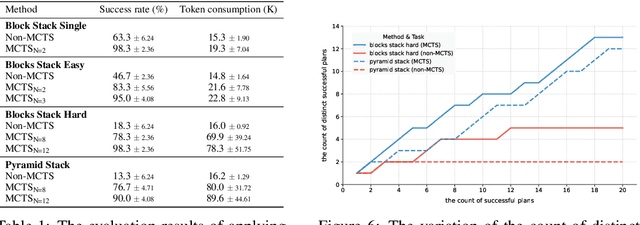

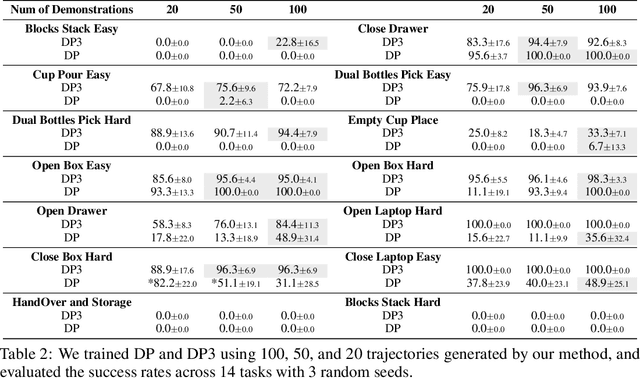
Abstract:For robotic manipulation, existing robotics datasets and simulation benchmarks predominantly cater to robot-arm platforms. However, for humanoid robots equipped with dual arms and dexterous hands, simulation tasks and high-quality demonstrations are notably lacking. Bimanual dexterous manipulation is inherently more complex, as it requires coordinated arm movements and hand operations, making autonomous data collection challenging. This paper presents HumanoidGen, an automated task creation and demonstration collection framework that leverages atomic dexterous operations and LLM reasoning to generate relational constraints. Specifically, we provide spatial annotations for both assets and dexterous hands based on the atomic operations, and perform an LLM planner to generate a chain of actionable spatial constraints for arm movements based on object affordances and scenes. To further improve planning ability, we employ a variant of Monte Carlo tree search to enhance LLM reasoning for long-horizon tasks and insufficient annotation. In experiments, we create a novel benchmark with augmented scenarios to evaluate the quality of the collected data. The results show that the performance of the 2D and 3D diffusion policies can scale with the generated dataset. Project page is https://openhumanoidgen.github.io.
KP-PINNs: Kernel Packet Accelerated Physics Informed Neural Networks
Jun 11, 2025Abstract:Differential equations are involved in modeling many engineering problems. Many efforts have been devoted to solving differential equations. Due to the flexibility of neural networks, Physics Informed Neural Networks (PINNs) have recently been proposed to solve complex differential equations and have demonstrated superior performance in many applications. While the L2 loss function is usually a default choice in PINNs, it has been shown that the corresponding numerical solution is incorrect and unstable for some complex equations. In this work, we propose a new PINNs framework named Kernel Packet accelerated PINNs (KP-PINNs), which gives a new expression of the loss function using the reproducing kernel Hilbert space (RKHS) norm and uses the Kernel Packet (KP) method to accelerate the computation. Theoretical results show that KP-PINNs can be stable across various differential equations. Numerical experiments illustrate that KP-PINNs can solve differential equations effectively and efficiently. This framework provides a promising direction for improving the stability and accuracy of PINNs-based solvers in scientific computing.
MTL-UE: Learning to Learn Nothing for Multi-Task Learning
May 08, 2025Abstract:Most existing unlearnable strategies focus on preventing unauthorized users from training single-task learning (STL) models with personal data. Nevertheless, the paradigm has recently shifted towards multi-task data and multi-task learning (MTL), targeting generalist and foundation models that can handle multiple tasks simultaneously. Despite their growing importance, MTL data and models have been largely neglected while pursuing unlearnable strategies. This paper presents MTL-UE, the first unified framework for generating unlearnable examples for multi-task data and MTL models. Instead of optimizing perturbations for each sample, we design a generator-based structure that introduces label priors and class-wise feature embeddings which leads to much better attacking performance. In addition, MTL-UE incorporates intra-task and inter-task embedding regularization to increase inter-class separation and suppress intra-class variance which enhances the attack robustness greatly. Furthermore, MTL-UE is versatile with good supports for dense prediction tasks in MTL. It is also plug-and-play allowing integrating existing surrogate-dependent unlearnable methods with little adaptation. Extensive experiments show that MTL-UE achieves superior attacking performance consistently across 4 MTL datasets, 3 base UE methods, 5 model backbones, and 5 MTL task-weighting strategies.
Beyond the Horizon: Decoupling UAVs Multi-View Action Recognition via Partial Order Transfer
Apr 29, 2025Abstract:Action recognition in unmanned aerial vehicles (UAVs) poses unique challenges due to significant view variations along the vertical spatial axis. Unlike traditional ground-based settings, UAVs capture actions from a wide range of altitudes, resulting in considerable appearance discrepancies. We introduce a multi-view formulation tailored to varying UAV altitudes and empirically observe a partial order among views, where recognition accuracy consistently decreases as the altitude increases. This motivates a novel approach that explicitly models the hierarchical structure of UAV views to improve recognition performance across altitudes. To this end, we propose the Partial Order Guided Multi-View Network (POG-MVNet), designed to address drastic view variations by effectively leveraging view-dependent information across different altitude levels. The framework comprises three key components: a View Partition (VP) module, which uses the head-to-body ratio to group views by altitude; an Order-aware Feature Decoupling (OFD) module, which disentangles action-relevant and view-specific features under partial order guidance; and an Action Partial Order Guide (APOG), which leverages the partial order to transfer informative knowledge from easier views to support learning in more challenging ones. We conduct experiments on Drone-Action, MOD20, and UAV datasets, demonstrating that POG-MVNet significantly outperforms competing methods. For example, POG-MVNet achieves a 4.7% improvement on Drone-Action dataset and a 3.5% improvement on UAV dataset compared to state-of-the-art methods ASAT and FAR. The code for POG-MVNet will be made available soon.
Adaptive Decision Boundary for Few-Shot Class-Incremental Learning
Apr 15, 2025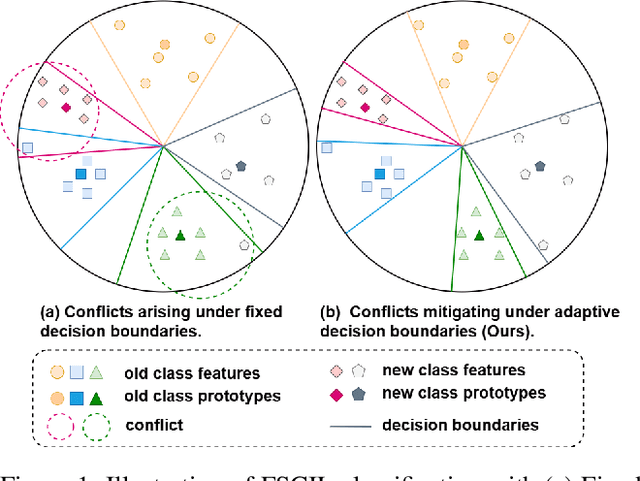
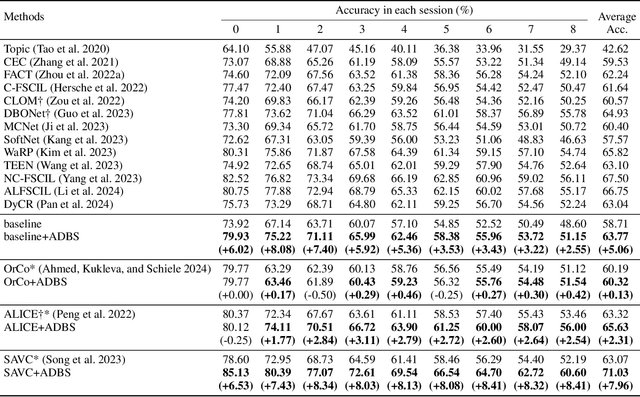
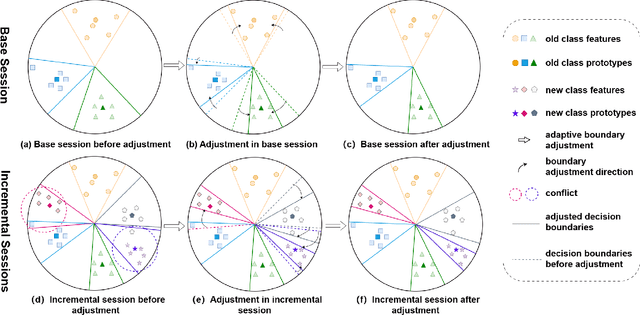
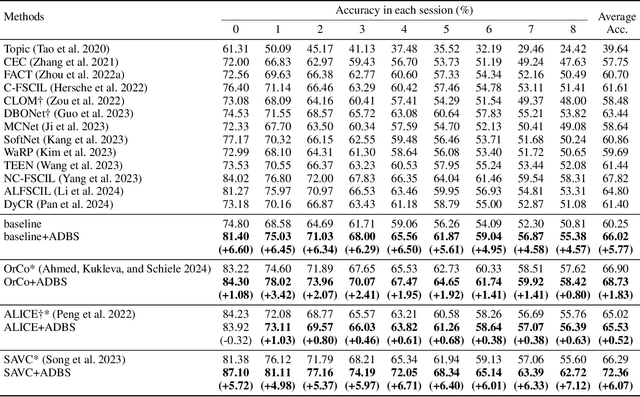
Abstract:Few-Shot Class-Incremental Learning (FSCIL) aims to continuously learn new classes from a limited set of training samples without forgetting knowledge of previously learned classes. Conventional FSCIL methods typically build a robust feature extractor during the base training session with abundant training samples and subsequently freeze this extractor, only fine-tuning the classifier in subsequent incremental phases. However, current strategies primarily focus on preventing catastrophic forgetting, considering only the relationship between novel and base classes, without paying attention to the specific decision spaces of each class. To address this challenge, we propose a plug-and-play Adaptive Decision Boundary Strategy (ADBS), which is compatible with most FSCIL methods. Specifically, we assign a specific decision boundary to each class and adaptively adjust these boundaries during training to optimally refine the decision spaces for the classes in each session. Furthermore, to amplify the distinctiveness between classes, we employ a novel inter-class constraint loss that optimizes the decision boundaries and prototypes for each class. Extensive experiments on three benchmarks, namely CIFAR100, miniImageNet, and CUB200, demonstrate that incorporating our ADBS method with existing FSCIL techniques significantly improves performance, achieving overall state-of-the-art results.
Temporal-Guided Spiking Neural Networks for Event-Based Human Action Recognition
Mar 21, 2025



Abstract:This paper explores the promising interplay between spiking neural networks (SNNs) and event-based cameras for privacy-preserving human action recognition (HAR). The unique feature of event cameras in capturing only the outlines of motion, combined with SNNs' proficiency in processing spatiotemporal data through spikes, establishes a highly synergistic compatibility for event-based HAR. Previous studies, however, have been limited by SNNs' ability to process long-term temporal information, essential for precise HAR. In this paper, we introduce two novel frameworks to address this: temporal segment-based SNN (\textit{TS-SNN}) and 3D convolutional SNN (\textit{3D-SNN}). The \textit{TS-SNN} extracts long-term temporal information by dividing actions into shorter segments, while the \textit{3D-SNN} replaces 2D spatial elements with 3D components to facilitate the transmission of temporal information. To promote further research in event-based HAR, we create a dataset, \textit{FallingDetection-CeleX}, collected using the high-resolution CeleX-V event camera $(1280 \times 800)$, comprising 7 distinct actions. Extensive experimental results show that our proposed frameworks surpass state-of-the-art SNN methods on our newly collected dataset and three other neuromorphic datasets, showcasing their effectiveness in handling long-range temporal information for event-based HAR.
SpaceSeg: A High-Precision Intelligent Perception Segmentation Method for Multi-Spacecraft On-Orbit Targets
Mar 14, 2025Abstract:With the continuous advancement of human exploration into deep space, intelligent perception and high-precision segmentation technology for on-orbit multi-spacecraft targets have become critical factors for ensuring the success of modern space missions. However, the complex deep space environment, diverse imaging conditions, and high variability in spacecraft morphology pose significant challenges to traditional segmentation methods. This paper proposes SpaceSeg, an innovative vision foundation model-based segmentation framework with four core technical innovations: First, the Multi-Scale Hierarchical Attention Refinement Decoder (MSHARD) achieves high-precision feature decoding through cross-resolution feature fusion via hierarchical attention. Second, the Multi-spacecraft Connected Component Analysis (MS-CCA) effectively resolves topological structure confusion in dense targets. Third, the Spatial Domain Adaptation Transform framework (SDAT) eliminates cross-domain disparities and resist spatial sensor perturbations through composite enhancement strategies. Finally, a custom Multi-Spacecraft Segmentation Task Loss Function is created to significantly improve segmentation robustness in deep space scenarios. To support algorithm validation, we construct the first multi-scale on-orbit multi-spacecraft semantic segmentation dataset SpaceES, which covers four types of spatial backgrounds and 17 typical spacecraft targets. In testing, SpaceSeg achieves state-of-the-art performance with 89.87$\%$ mIoU and 99.98$\%$ mAcc, surpassing existing best methods by 5.71 percentage points. The dataset and code are open-sourced at https://github.com/Akibaru/SpaceSeg to provide critical technical support for next-generation space situational awareness systems.
Reconciling Stochastic and Deterministic Strategies for Zero-shot Image Restoration using Diffusion Model in Dual
Mar 03, 2025Abstract:Plug-and-play (PnP) methods offer an iterative strategy for solving image restoration (IR) problems in a zero-shot manner, using a learned \textit{discriminative denoiser} as the implicit prior. More recently, a sampling-based variant of this approach, which utilizes a pre-trained \textit{generative diffusion model}, has gained great popularity for solving IR problems through stochastic sampling. The IR results using PnP with a pre-trained diffusion model demonstrate distinct advantages compared to those using discriminative denoisers, \ie improved perceptual quality while sacrificing the data fidelity. The unsatisfactory results are due to the lack of integration of these strategies in the IR tasks. In this work, we propose a novel zero-shot IR scheme, dubbed Reconciling Diffusion Model in Dual (RDMD), which leverages only a \textbf{single} pre-trained diffusion model to construct \textbf{two} complementary regularizers. Specifically, the diffusion model in RDMD will iteratively perform deterministic denoising and stochastic sampling, aiming to achieve high-fidelity image restoration with appealing perceptual quality. RDMD also allows users to customize the distortion-perception tradeoff with a single hyperparameter, enhancing the adaptability of the restoration process in different practical scenarios. Extensive experiments on several IR tasks demonstrate that our proposed method could achieve superior results compared to existing approaches on both the FFHQ and ImageNet datasets.
Progressive Vision-Language Prompt for Multi-Organ Multi-Class Cell Semantic Segmentation with Single Branch
Dec 04, 2024



Abstract:Pathological cell semantic segmentation is a fundamental technology in computational pathology, essential for applications like cancer diagnosis and effective treatment. Given that multiple cell types exist across various organs, with subtle differences in cell size and shape, multi-organ, multi-class cell segmentation is particularly challenging. Most existing methods employ multi-branch frameworks to enhance feature extraction, but often result in complex architectures. Moreover, reliance on visual information limits performance in multi-class analysis due to intricate textural details. To address these challenges, we propose a Multi-OrgaN multi-Class cell semantic segmentation method with a single brancH (MONCH) that leverages vision-language input. Specifically, we design a hierarchical feature extraction mechanism to provide coarse-to-fine-grained features for segmenting cells of various shapes, including high-frequency, convolutional, and topological features. Inspired by the synergy of textual and multi-grained visual features, we introduce a progressive prompt decoder to harmonize multimodal information, integrating features from fine to coarse granularity for better context capture. Extensive experiments on the PanNuke dataset, which has significant class imbalance and subtle cell size and shape variations, demonstrate that MONCH outperforms state-of-the-art cell segmentation methods and vision-language models. Codes and implementations will be made publicly available.
AerialGo: Walking-through City View Generation from Aerial Perspectives
Nov 29, 2024



Abstract:High-quality 3D urban reconstruction is essential for applications in urban planning, navigation, and AR/VR. However, capturing detailed ground-level data across cities is both labor-intensive and raises significant privacy concerns related to sensitive information, such as vehicle plates, faces, and other personal identifiers. To address these challenges, we propose AerialGo, a novel framework that generates realistic walking-through city views from aerial images, leveraging multi-view diffusion models to achieve scalable, photorealistic urban reconstructions without direct ground-level data collection. By conditioning ground-view synthesis on accessible aerial data, AerialGo bypasses the privacy risks inherent in ground-level imagery. To support the model training, we introduce AerialGo dataset, a large-scale dataset containing diverse aerial and ground-view images, paired with camera and depth information, designed to support generative urban reconstruction. Experiments show that AerialGo significantly enhances ground-level realism and structural coherence, providing a privacy-conscious, scalable solution for city-scale 3D modeling.
 Add to Chrome
Add to Chrome Add to Firefox
Add to Firefox Add to Edge
Add to Edge